Related Research Articles

The Province of Canada was a British colony in British North America from 1841 to 1867. Its formation reflected recommendations made by John Lambton, 1st Earl of Durham, in the Report on the Affairs of British North America following the Rebellions of 1837–1838.
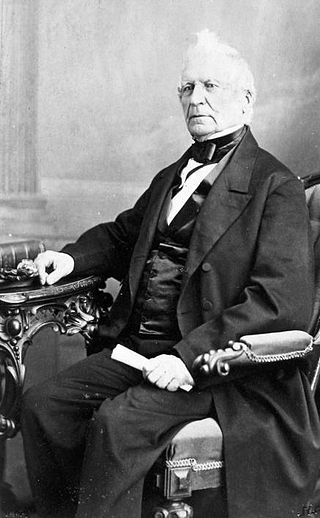
Louis-Joseph Papineau, born in Montreal, Quebec, was a politician, lawyer, and the landlord of the seigneurie de la Petite-Nation. He was the leader of the reformist Patriote movement before the Lower Canada Rebellion of 1837–1838. His father was Joseph Papineau, also a politician in Quebec. Papineau was the eldest of eight children and was the grandfather of the journalist Henri Bourassa, founder of the newspaper Le Devoir.
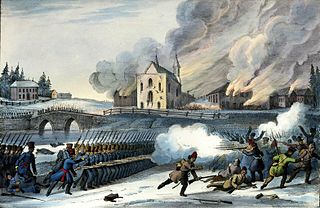
The Lower Canada Rebellion, commonly referred to as the Patriots' War in French, is the name given to the armed conflict in 1837–38 between rebels and the colonial government of Lower Canada. Together with the simultaneous rebellion in the neighbouring colony of Upper Canada, it formed the Rebellions of 1837–38.

Cornelius David Krieghoff was a Dutch-born Canadian-American painter of the 19th century. He is best known for his paintings of Canadian genre scenes involving landscapes and outdoor life, which were as sought after in his own time as they are today. He painted many winter scenes, some in several variants.

Events from the year 1872 in Canada.

Events from the year 1849 in Canada.

The Ostend Manifesto, also known as the Ostend Circular, was a document written in 1854 that described the rationale for the United States to purchase Cuba from Spain while implying that the U.S. should declare war if Spain refused. Cuba's annexation had long been a goal of U.S. slaveholding expansionists. At the national level, American leaders had been satisfied to have the island remain in weak Spanish hands so long as it did not pass to a stronger power such as Britain or France. The Ostend Manifesto proposed a shift in foreign policy, justifying the use of force to seize Cuba in the name of national security. It resulted from debates over slavery in the United States, manifest destiny, and the Monroe Doctrine, as slaveholders sought new territory for the expansion of slavery.
The Parti rouge was a political group that contested elections in the Eastern section of the Province of Canada. It was formed around 1847 by radical French-Canadians inspired by the ideas of Louis-Joseph Papineau, the Institut canadien de Montréal, and the reformist movement led by the Parti patriote of the 1830s.

From the independence of the United States until today, various movements within Canada have campaigned in favour of U.S. annexation of parts or all of Canada. Historical studies have focused on numerous small-scale movements which are helpful in comparisons of Canadian and American politics.

Lieutenant General Sir Benjamin D'Urban was a British general and colonial administrator, who is best known for his frontier policy when he was the Governor in the Cape Colony.
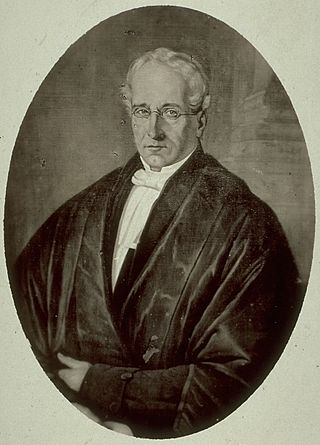
Austin Cuvillier was a businessman and political figure in Lower Canada and Canada East. He was a successful Canadien businessmen, unusual when most businessmen in Lower Canada were British. He also was a member of the Legislative Assembly of Lower Canada for twenty years, as a member for the Parti canadien, which tended to oppose the policies of the British-appointed governors. As a result, he served as a bridge between the conservative business community, and the more radical Parti canadien, although he finally broke with the Parti canadien prior to the Lower Canada Rebellion of 1837–1838.

Starting with the 1763 Treaty of Paris, New France, of which the colony of Canada was a part, formally became a part of the British Empire. The Royal Proclamation of 1763 enlarged the colony of Canada under the name of the Province of Quebec, which with the Constitutional Act 1791 became known as the Canadas. With the Act of Union 1840, Upper and Lower Canada were joined to become the United Province of Canada.

George Moffatt was a businessman and political figure in Lower Canada and Canada East. Born in England, he emigrated to Lower Canada at the age of 14. He became involved in business in Montreal, including the fur trade.
Thomas Boutillier was a doctor, Patriote, and politician in Lower Canada. Elected to the Legislative Assembly of Lower Canada in 1834, he was a member of the Parti patriote led by Louis-Joseph Papineau, which was challenging the British colonial government of the largely French-speaking province of Lower Canada. When the Lower Canada Rebellion broke out in 1837, he fought on the Patriote side in the Battle of Saint-Charles. Following the Patriotes' defeat, he fled to the United States. He returned to Lower Canada in 1838.
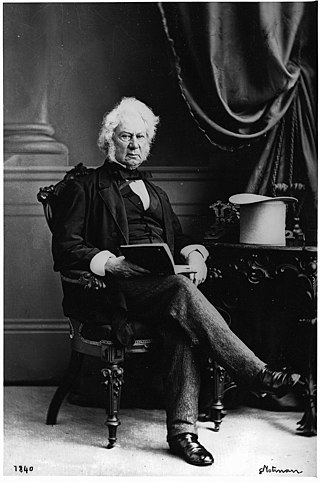
Benjamin Holmes was a Lower Canada businessman and political figure. He served in the militia of Lower Canada during the War of 1812, including a period of captivity by the American forces. He joined the Bank of Montreal shortly after it formed in 1817, and rose to be the cashier by 1827. He was twice a member of the Legislative Assembly of the Province of Canada. In spite of his service in the War of 1812, he was a supporter of annexation by the United States in the late 1840s, and a signatory of the Montreal Annexation Manifesto. He became a vice-president of the Grand Trunk Railway, and also a director of the Bank of Montreal.
Jacob De Witt was a businessman, banker and political figure in Lower Canada and Canada East, Province of Canada. Beginning in the hardware trade, he expanded into steamship transportation on the River St. Lawrence and then banking. He was elected to the Legislative Assembly of Lower Canada and generally supported the Parti patriote, but did not participate in the Lower Canada Rebellion of 1837. After the union of Lower Canada and Upper Canada into the Province of Canada, he was elected to the new Legislative Assembly. He initially supported the reform measures of Louis-Hippolyte LaFontaine, but gradually became more radical, ending his political career as member of the Parti rouge and calling for the voluntary annexation of Canada to the United States. He continued in business, particularly banking, until his death in 1859.

By the arrangements of the Canadian federation, Canada's monarchy operates in Ontario as the core of the province's Westminster-style parliamentary democracy. As such, the Crown within Ontario's jurisdiction may be referred to as the Crown in Right of Ontario, His Majesty in Right of Ontario, the King in Right of Ontario, or His Majesty the King in Right of Ontario. The Constitution Act, 1867, leaves many functions in Ontario specifically assigned to the sovereign's viceroy, the lieutenant governor of Ontario, whose direct participation in governance is limited by the constitutional conventions of constitutional monarchy.

By the arrangements of the Canadian federation, Canada's monarchy operates in Quebec as the core of the province's Westminster-style parliamentary democracy and constitution. As such, the Crown within Quebec's jurisdiction is referred to as the Crown in Right of Quebec, His Majesty in Right of Quebec, or the King in Right of Quebec. The Constitution Act, 1867, however, leaves many royal duties in the province specifically assigned to the sovereign's viceroy, the lieutenant governor of Quebec, whose direct participation in governance is limited by the conventional stipulations of constitutional monarchy.
The following is an incomplete bibliography of the 1837-1838 insurrections in Lower Canada in the English and French languages, by publication date and document type.
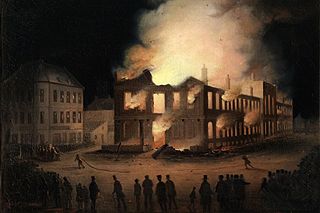
The burning of the Parliament Buildings in Montreal was an important event in pre-Confederation Canadian history and occurred on the night of April 25, 1849, in Montreal, the then-capital of the Province of Canada. It is considered a crucial moment in the development of the Canadian democratic tradition, largely as a consequence of how the matter was dealt with by then co-prime ministers of the united Province of Canada, Sir Louis-Hippolyte Lafontaine and Robert Baldwin.
References
- 1 2 3 4 Tetley, William (September 14, 2006), "Cornelius Krieghoff, the Shakspeare Club and the Annexation Manifesto" (PDF), Tetley's maritime & admiralty law website, Montreal, QC, Canada: McGill University , retrieved November 7, 2009,
Equally important and disturbing is the fact that on October 11, 1849 a manifesto (dated September 14, 1849) was presented favouring the annexation of Lower Canada to the United States.
- ↑ Ontario History. Vol. 62. Ontario Historical Society. 1970. p. 41.
- ↑ Patrick Richard Carstens and Timothy L (2013). The Republic of Canada Almost. Xlibris Corporation. p. 352. ISBN 978-1-4797-4915-7.
- 1 2 Monet, Jacques, "Annexation Association", The Canadian Encyclopedia , Toronto, ON, Canada: The Historica Dominion Institute, OCLC 439558183, archived from the original on August 16, 2007, retrieved November 7, 2009,
Annexation Association, founded 1849 to promote Canada-US political union. In October and December it published 2 versions of the "Annexation Manifesto."
- ↑ Publications of the Hudson's Bay Record Society. 1959. p. 795.
- ↑ W.P. Morrell (28 October 2013). British Colonial Policy in the Age of Peel and Russell. Taylor & Francis. p. 162. ISBN 978-1-136-24353-0.
- ↑ Reginald C. Stuart (1988). United States Expansionism and British North America, 1775-1871 . University of North Carolina Press. p. 94. ISBN 978-0-8078-1767-4.
- ↑ Gordon Martel; Wayne Lavender (16 June 1986). Studies in British Imperial History: Essays in Honour of A.P. Thornton. Palgrave Macmillan UK. pp. 71–72. ISBN 978-1-349-18244-2.